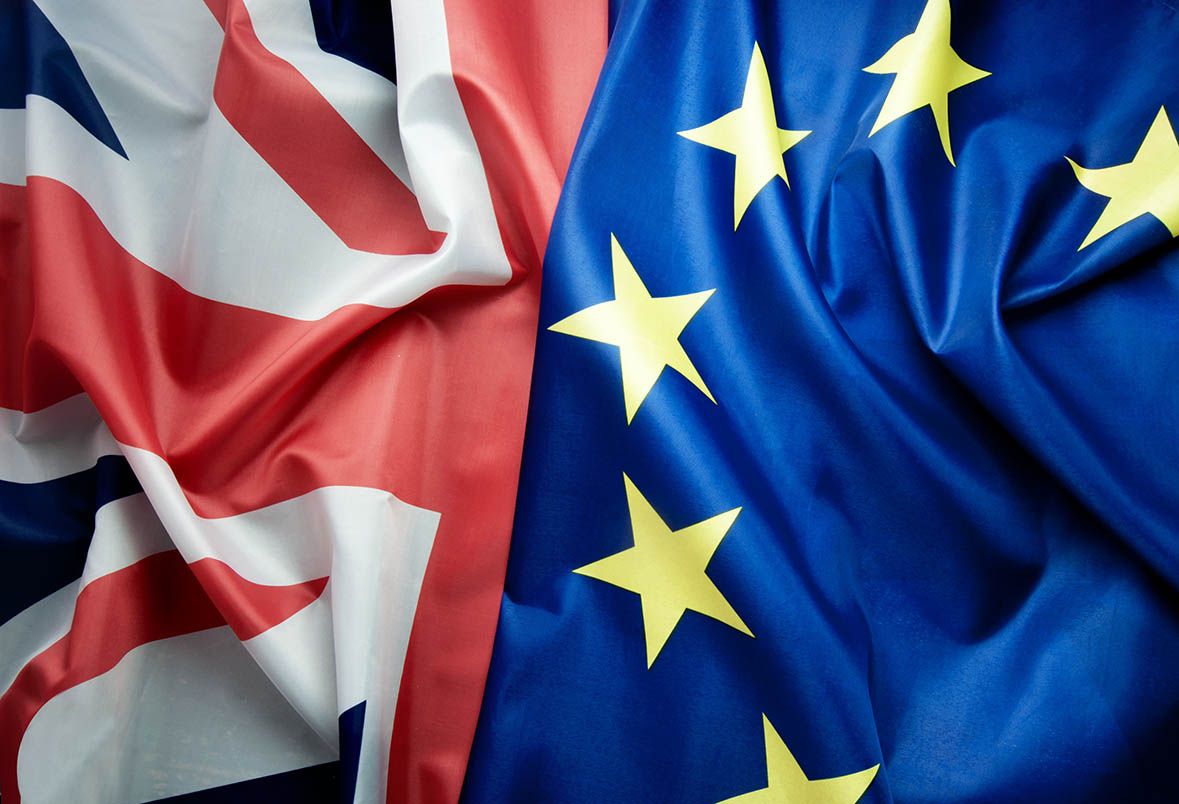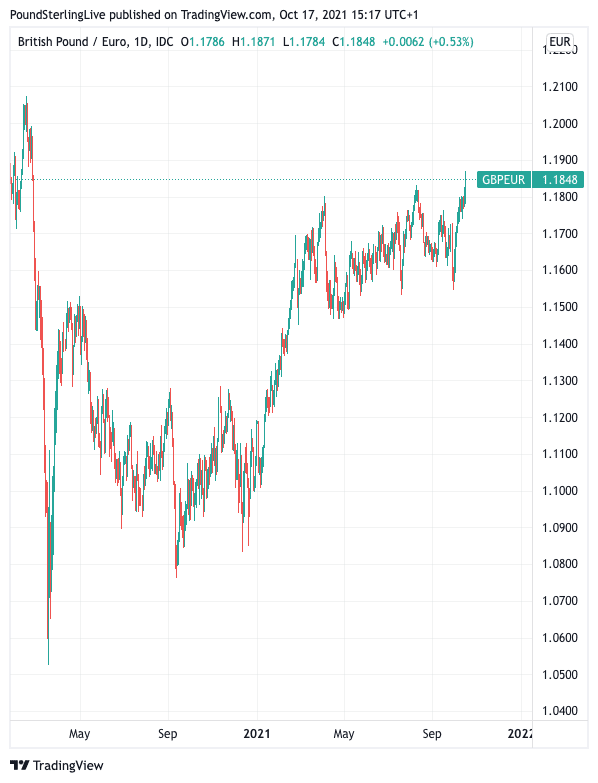Pound Sterling / Euro Rate Week Ahead Forecast: Technical Breach Points to Further Gains, Eyes on Inflation Data
- Written by: Gary Howes
-
- GBP/EUR at 20 month highs
- Key technical levels broken
- But gains will rely on supportive global markets
- And rate hike expectations
- Bailey says Sunday Bank likely to raise rates
- Watch inflation data due Wednesday

Image © Adobe Images
Spot Market Rate at Publication:
GBP/EUR: 1.1855
The Pound to Euro exchange rate (GBP/EUR) has broken through a major resistance level suggesting the technical outlook has improved markedly; however gains will require an ongoing supportive global backdrop and generous Bank of England rate hike expectations.
From a UK calendar perspective the highlight of the coming week will be Wednesday's release of inflation data.
It is difficult to ascertain just how the data will impact Sterling: typically stronger-than-expected data would be deemed supportive of the UK currency and this could indeed prove to be the case.
But 2021 has seen the word 'stagflation' increasingly mentioned and we could in fact see softer-than-forecast inflation proving supportive of the Pound as this would bode well for UK consumers, a major engine of the economy.
There is no certainty as to how the market will treat the data and the reaction could send a clear signal as to what regime the market is currently trading.
Above: Daily GBP/EUR chart.
Secure a retail exchange rate that is between 3-5% stronger than offered by leading banks, learn more.
Mathias Van der Jeugt at KBC Markets says technical considerations have "definitely played a role" in Pound Sterling's recent behaviour against the Euro.
He says the weekly close at 1.1855 improves Sterling's technical outlook.
The close at 1.1855 means resistance at 1.1806 (the previous 2021 high) has finally yielded and "important" resistance at 1.1834 has also given way.
A weekly close above these key figures provides Van der Jeugt with confirmation that "would surely improve the technical picture."
Pound Sterling's new 2021 high against the Euro came courtesy of a number of factors, which include the aforementioned breach of technical resistance, expectations for higher interest rates at the Bank of England and rising global stock markets.
Rising markets signify a returning confidence to investors which creates a backdrop that tends to favour the Pound against the Euro and Dollar, owing to Sterling's 'high beta' status.
It would appear a number of anxieties that dominated in the September-early October period have been digested by markets: 1) global growth is slowing 2) inflation is set higher and 3) central banks - particularly the Fed - are heading towards a higher interest rate setting.
Investors are nevertheless nervous and further setbacks to sentiment are likely over coming days, in which case the Pound could decline.
The odds of a Bank of England interest rate rise taking place in November remain elevated after Governor Andrew Bailey said at the weekend the Bank is set to raise interest rates as inflation risks arise.
Speaking to the Group of 30 - an international body of economic and financial leaders - Bailey said the recent jump in inflation would be temporary, but a surge in energy prices would push it higher and make its climb last longer.
This raised the risk of higher inflation expectations, he said.
"Monetary policy cannot solve supply-side problems - but it will have to act and must do so if we see a risk, particularly to medium-term inflation and to medium-term inflation expectations," Bailey said.
{wbamp-hide start}
{wbamp-hide end}{wbamp-show start}{wbamp-show end}
Foreign exchange analysts at Goldman Sachs say the Bank's policy to tighten conditions (raise interest rates, end quantitative easing) comes amidst heightened concerns about the surge in inflation expectations.
Goldman Sachs economists now expect a Bank Rate hike at the November 4 MPC meeting.
"In general, weaker domestic growth is negative for a currency, but higher front-end rates are a positive," says Zach Pandl, a foreign exchange strategist at Goldman Sachs.
"On net, the shift in monetary policy should outweigh the negative effects on the currency from slower growth in this case, resulting in modest Sterling appreciation on the margin," he adds.
Researchers at the Wall Street bank say the Bank of England's nod to raising interest rates will likely be sufficient to support the domestic currency, partly to limit inflation risks from import prices, even if this introduces more downside risks to growth.
The UK is a net importer of goods, therefore a stronger currency lowers the relative value of these imports, in turn fading domestic inflationary pressures. In this instance, higher rates and lower inflation (particularly via taking the sting out of the cost of energy imports) is supportive of the economic outlook.
The rally in the Pound-Euro exchange rate is particularly deflationary in that the EU is the UK's largest trading partner.
"Policy tightening caused by a supply shock should be less positive for FX than equivalent tightening caused by a demand shock, but concerns that BoE rate hikes will result in Sterling depreciation (as growth expectations spiral downward) are misplaced," says Pandl.
(The "misplaced" expectations mentioned here are those held by analysts who say a rate rise at the Bank of England would be a mistake in that it lowers UK economic growth potential further. A decline in the value of the Pound in late September was attributed to this 'policy mistake' thinking).
"Look for modest further downsinde in EUR/GBP ahead of the November MPC meeting," says Pandl.
Inflation: What to Watch
The key economic release to consider in the weeks head is Wednesday's inflation data for September.
The market is looking for CPI to have increased 3.2% year-on-year, which would be unchanged on the previous month's reading.
As mentioned as of yet, it is unclear whether a stronger or weaker print will be positive for the Pound.
However, we would favour reverting to the old-fashioned assumption that stronger-than-expected inflation is supportive given the strong rise in the value of the Pound to rate hike expectations over recent days.
Hann-Ju Ho, Economist at Lloyds Bank says inflation could even fall as low as 3.0% year-on-year, partly as a result of the base effects from the end of the Eat Out to Help Out Scheme on prices a year ago.
"But it will be a temporary respite from inflation’s march up to and probably beyond 4% in the coming months. The increase in the energy price cap will pull inflation higher in October, with a further
significant rise likely next April as a result of soaring wholesale gas prices," says Ho.
Lloyds Bank find inflation looks set to remain above 4% - twice the Bank of England's target - into the second quarter of next year.
"It will present the MPC with a difficult policy trade-off between supporting the economy and tackling inflation," says Ho.
Also worth watching is the release of preliminary PMI data for October, due out on Friday 22 October.
The data will give an insight into how the UK economy performed during the fuel shortages earlier in the month and amidst rising inflation expectations and supply chain constraints.
A stronger-than-expected set of numbers would support the Pound. The data will also give an insight into how hiking intentions at UK businesses are evolving.
Strong demand for labour should signal the ending of the furlough scheme at the end of September will not materially impact unemployment, which could yet further cement expectations for a Bank of England rate hike.

